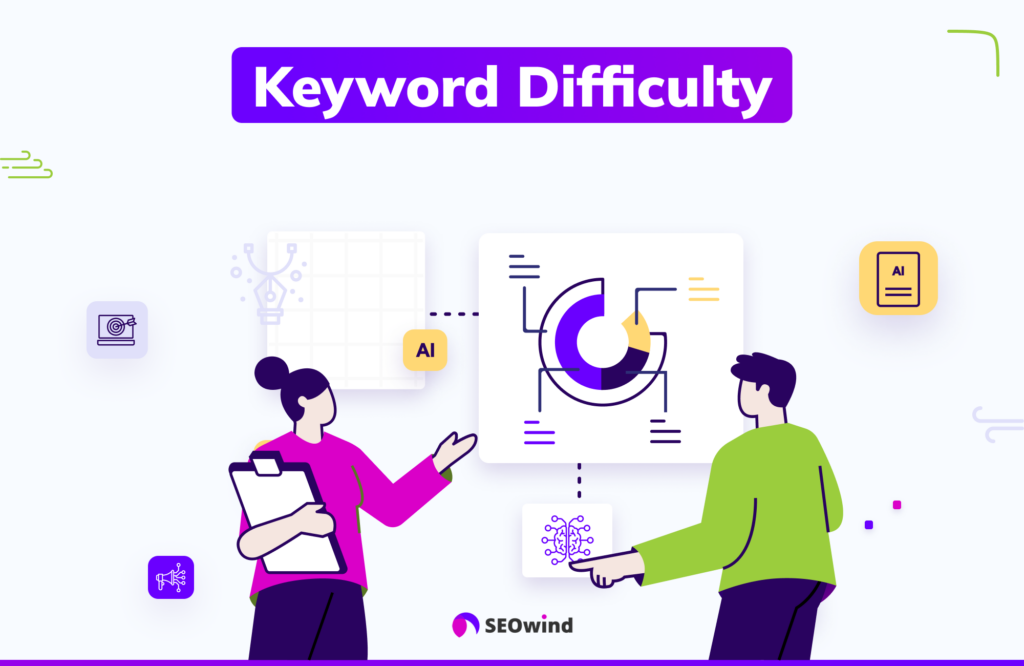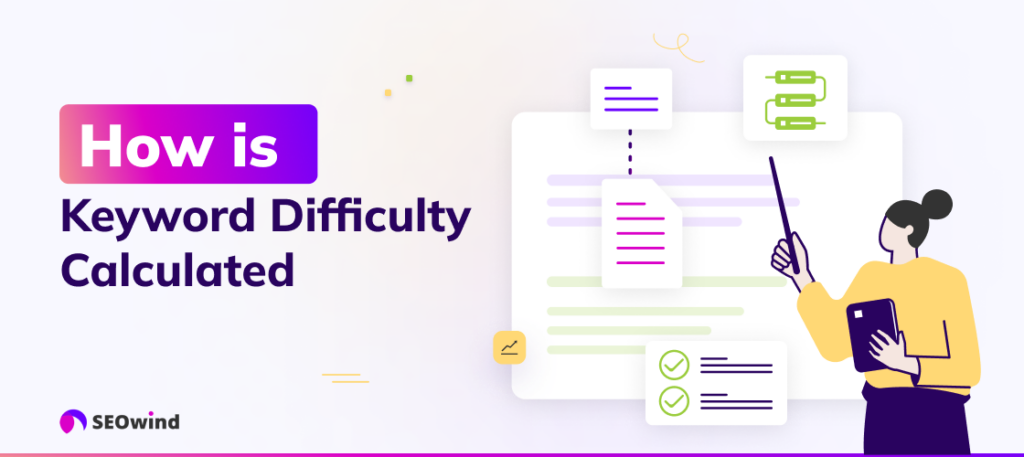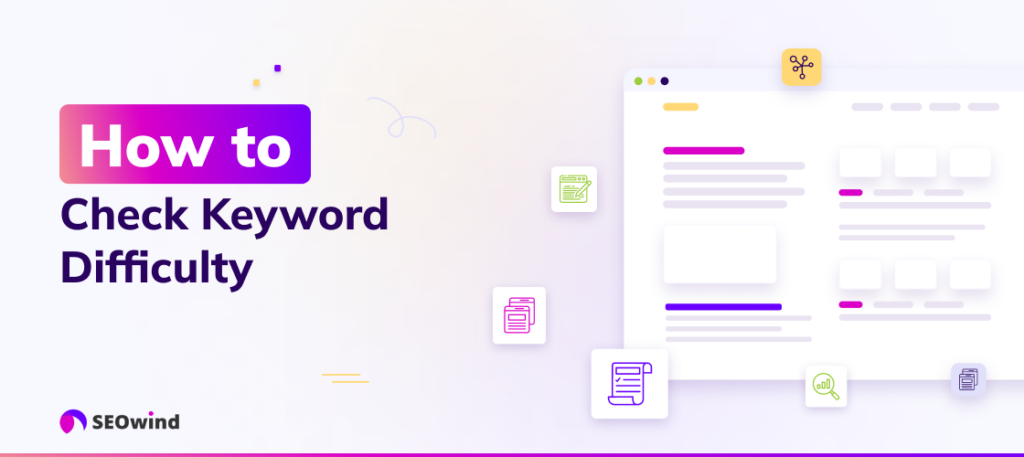The quest for high search engine rankings is a never-ending endeavor for digital marketers and content creators. One vital factor to consider to achieve those coveted spots is keyword difficulty. By understanding its ins and outs, you can unlock better strategic decisions when crafting your SEO strategy. This comprehensive guide will delve deep into keyword difficulty analysis, explaining its significance, how it’s calculated, and what you can do about it.

What is Keyword Difficulty? #
Keyword difficulty (also known as keyword competition or SEO keyword difficulty) refers to the effort one must put forth to rank organically on search engines for a specific search term. It indicates how tough it might be to break through existing competitors to secure prominent positions in SERPs (Search Engine Results Pages).
Evaluating keyword difficulty allows marketing professionals and business owners to decide which keywords are worth targeting while optimizing their website content and employing other organic promotion tactics. Ultimately, assessing this crucial metric facilitates the identification of keywords that strike an ideal balance between being relevant with sufficient search volume and attainable based on your website’s authority.
By grasping the concept of keyword difficulty, you will improve your chances of outranking your competitors and save time and resources by avoiding highly competitive but equally saturated keywords that might prove challenging to conquer. So let’s dive deeper into the factors used in determining keyword difficulty scores—helping you stay ahead of the competition in today’s ever-changing digital landscape.
How is Keyword Difficulty Calculated? #

Keyword difficulty calculation involves evaluating and ranking various factors associated with organic search competition. This assessment can help you understand how challenging it will be to rank in the top positions for a keyword in search engines such as Google. Here is a detailed look at some of the key factors that contribute to calculating keyword difficulty:
Factors of Keyword Difficulty #
Before analyzing keywords, it’s crucial to understand the main components responsible for determining keyword competition. These elements comprise competitors, domain authority, content quality, and search intent.
Competitors #
Competitor analysis is essential when assessing keyword difficulty, as stronger competitors often dominate high-ranking positions in search results. An intense competitive landscape signifies increased effort to outrank other websites targeting the same keywords.
To identify your potential competitors within this realm:
- Review websites currently ranking in the top 10 or 20 positions for your target keywords.
- Gauge their competitiveness based on metrics such as backlink profile, relevance, site structure, and user engagement.
- Monitor changes over time to stay informed about emergent players affecting overall keyword difficulty dynamics.
Domain Authority #
Domain Authority (DA) is an SEO metric developed by MOZ that predicts how likely a website will perform well in search engine rankings based on its credibility, trustworthiness, and link profiles. A higher domain authority typically translates into better rankings within search results.
To analyze DA when assessing keyword difficulty:
- Check the DA score of competing websites ranking for your targeted keywords.
- Determine if your website’s DA score is at par or above your strongest competitors.
- Strategize ways to enhance your website’s DA by acquiring high-quality backlinks from authoritative sources.
Having a stronger domain authority than existing competitors gives you a distinct advantage when trying to surpass them organically.
Content Quality #
Presenting valuable content that resonates with users is key to outranking competitors. Google’s algorithms prioritize websites featuring relevant, well-structured, and informative content.
When gauging the quality of your competitors’ content as it relates to keyword difficulty:
- Examine their website for readability, depth of information, visual elements, formatting consistency, and whether they effectively address users’ search queries.
- Look for areas where your content surpasses your competition’s or unique angles through which you can approach the topic.
- Continuously improve your content’s performance by tracking user engagement metrics such as bounce rate and session duration.
Focusing on high-quality content distinguishes you from other players within your niche ecosystem.
Search Intent #
Search intent is the primary motivation behind a user’s query in a search engine. It is essential to cater to this aspect when developing an SEO strategy since fulfilling user requirements impacts rankings heavily.
In terms of understanding search intent for keyword difficulty calculation:
- Classify target keywords according to their intents (informational, transactional, navigational).
- Identify how competing websites address specific search intents through on-page optimization strategies such as H-tags organization and appropriate metadata usage.
- Optimize your website accordingly to deliver more value than competitors targeting keywords with similar intent characteristics.
Catering optimally to search intent helps with better rankings and enhances the overall user experience while visiting your website.
Why Should You Care About Keyword Difficulty? #
Understanding and assessing keyword difficulty is vital for the success of any SEO campaign or content marketing strategy. It affects your website’s visibility, ranking, and overall performance in search engine results pages (SERPs). In this section, let’s delve into why you should pay close attention to keyword difficulty when shaping your digital marketing efforts.
Better-Informed Decisions on Content Strategy #
First and foremost, comprehending keyword difficulty empowers you to make more informed decisions when setting up your content strategy. By considering a keyword’s competition and ranking difficulty, you can prioritize which keywords to target based on their potential to boost your website’s organic traffic. Selecting optimal keywords helps you create content that truly resonates with your audience and increases the likelihood of achieving higher rankings in SERPs.
Resource Optimization #
Knowing the keyword difficulty landscape enables you to optimize resources by focusing on those keywords within reach for your current domain authority. This way, you can allocate time, budget, and manpower effectively without wasting effort chasing highly competitive phrases that may be challenging to rank for initially. As a result, resource optimization leads to faster improvements in search engine visibility.
Balancing Long-Term Goals with Short-Term Results #
Recognizing various levels of keyword difficulty allows you to balance long-term SEO objectives with short-term achievements. While aiming for high-ranking yet difficult-to-target keywords is essential as part of an ambitious growth strategy, incorporating low-difficulty terms would yield quicker results and establish an initial online presence. Striking this balance boosts early successes while creating a pathway for future accomplishments.
Gaining Competitive Edge #
By effectively gauging keyword competition through comprehensive analysis tools like SEMrush or Ahrefs Keyword Explorer, one can uncover hidden opportunities within their niche market segments. These insights might reveal untapped areas ripe for targeting or emerging trends before they gain steam within your industry landscape—placing your business ahead of the competition curve.
In conclusion, understanding and incorporating keyword difficulty into your SEO strategy is crucial to making informed decisions that can help you rank better in search engine results pages. Keyword Difficulty helps optimize resources by focusing on potentially accessible keywords while balancing long-term goals with short-term results, setting yourself up for lasting online success.
How to Check Keyword Difficulty? #

Understanding the keyword difficulty is an essential part of your SEO strategy. You must use various tools and techniques that help analyze and measure the competition around specific keywords to do this. In this section, I’ll introduce some popular keyword difficulty checker tools and explain how to use them effectively.
- Google Ads Keyword Planner
Google’s Keyword Planner is a great starting point for checking keyword difficulty. While it was primarily designed for advertisers using their ad platform, it offers useful insights into organic search competition. Here’s how to check keyword difficulty using Google Ads Keyword Planner:
- Sign in or create a Google Ads account.
- Go to the “Tools” menu and select “Keyword Planner.”
- Click “Discover new keywords” and enter your target keyword(s).
- The results page will display search volume and a metric called “Competition,” indicating how many advertisers are bidding on the same keyword(s). Although not directly measuring organic search competitiveness, higher competition generally corresponds with increased difficulty.
2. Moz’s Keyword Explorer
Moz is well-known for its suite of SEO tools, including its powerful Keyword Explorer. This tool takes into account several factors to generate a Keyword Difficulty score ranging from 0-100 for any given query as follows:
- Log in or sign up for Moz Pro (a free trial is available).
- Navigate to the “Keyword Research > Keyword Explorer” section.
- Type in your desired keyword phrase and press Enter.
- The results page shows key metrics such as monthly search volume, clicks per month, and the discussed metric – “Keyword Difficulty.”
Remember that Moz’s scoring system relies heavily on Domain Authority (DA), so it may be not very objective toward websites with established DAs.
3. SEMrush
SEMrush offers another comprehensive approach to understanding keyword competition through its difficulty measurement. It provides an overall competitiveness score based on organic search volume, website backlinks, content relevance, and more. To assess keyword difficulty using SEMrush:
- Register for a free or premium account.
- Navigate to the “Keyword Overview” section under “SEO Toolkit.”
- Input your desired keyword phrase.
- The resulting analysis offers metrics such as search volume, CPC (Cost Per Click), and crucially – “Keyword Difficulty.”
While SEMrush does a great job combining quantitative metrics with practical analysis, it can only provide estimates of competition levels.
4. Ahrefs’ Keyword Explorer
Another popular choice for checking keyword difficulty is Ahrefs’ Keyword Explorer. Using its proprietary KD (Keyword Difficulty) score system, the tool grades keywords from easy-to-rank to incredibly difficult. To use this metric:
- Sign up for an Ahrefs account (trial or paid subscription).
- From the dashboard, click the “Keywords Explorer” tab.
- Enter your chosen keywords into the search box and analyze the results.
- Pay attention to the “KD” score displayed next to each keyword on the list.
The advantage of using Ahrefs lies in their extensive backlink database, which informs their evaluation process.
In conclusion, checking keyword difficulty is essential when deciding which keywords deserve focus in your SEO optimization efforts. By leveraging one or more of the tools I described above, you’ll gain valuable insights into how competitive particular keywords are within your industry’s digital space.
What is a Good Keyword Difficulty? #
Keyword difficulty, as a crucial factor in your SEO strategy, determines how challenging it would be to rank prominently for a specific keyword. While targeting high-volume, popular keywords may be tempting, understanding and choosing the right range of keyword difficulty can tremendously increase your chances of success. However, determining what constitutes a “good” keyword difficulty entirely depends on your website’s capacity and objectives.
When to Target Low, Medium, and High Difficulty Keywords? #
- Low Difficulty Keywords: Generally speaking, keywords with low search competition represent an excellent opportunity for websites looking to gain traction within their niche. This is particularly true for new websites or small businesses that might need to establish domain authority or the resources to compete against bigger players in the industry.
- To succeed with low-difficulty keywords:
- Aim at creating unique and valuable content around those terms
- Engage in strategic link-building efforts
- Optimize your website with proper on-page SEO
- Medium-Difficulty Keywords: As your online presence grows and you accumulate stronger domain authority over time, targeting medium-difficulty keywords becomes more viable. These terms generally have higher search volumes than lower-difficulty ones while offering less intense competition than those considered highly difficult ones.
When focusing on this category of keyword difficulty:
- Examine the top-ranking competitors in SERPs and analyze how they are optimizing their content
- Employ advanced strategies like semantic grouping of keywords or updating outdated content with fresh data
- Strengthen partnerships with authoritative sites for backlinks
- High Difficulty Keywords: As one can assume, these competitive terms are often associated with substantial organic traffic volumes and steep challenges when aiming to outrank market leaders. Nonetheless, well-established websites backed by considerable resources can target such high-difficulty keywords if they possess the prowess needed for intense competition.
- For success in tackling high-difficulty keywords:
- Deliver superior content in terms of quality, layout, and depth compared to existing competitors
- Develop a robust off-page SEO strategy that prioritizes backlinks from reputable websites
- Stay current with the latest SEO trends and follow a continuous optimization process for your content
In conclusion, knowing what level of keyword difficulty aligns with your website’s capabilities and objectives is crucial. By targeting low-to-medium difficulty keywords as you initially build your online presence and progressively aiming towards higher competition territory when your prowess allows it, you stand better chances at success while maximizing your efforts in SEO.
Top Takeaways #
In this article on keyword difficulty, we touched upon various crucial aspects for SEO professionals and marketers. Here’s a quick recap of the top takeaways to remember when diving into the world of keyword difficulty:
- Understanding Keyword Difficulty: Grasping the concept of keyword difficulty is essential as it helps you gauge how challenging it will be to rank well for a specific search term in organic search results.
- Calculating Keyword Difficulty: The process involves evaluating multiple factors such as competitors, domain authority, content quality, and search intent.
- Importance of Keyword Difficulty: Emphasizing keyword difficulty can significantly influence your SEO strategy by helping you choose target keywords wisely, prioritize resources, and optimize your efforts toward achieving better rankings.
- Checking Keyword Difficulty: Utilize reliable SEO tools and platforms like Ahrefs or SEMRush to check keyword difficulty scores with ease and accuracy.
- Interpreting Keyword Difficulty Scores: Understanding what constitutes good keyword difficulty enables you to make informed decisions when targeting different levels, such as low, medium, or high-ranking keywords – allowing you to balance competition with opportunity effectively.
- SEO Strategy Considerations: Recognizing how keyword competition affects your overall approach can greatly impact your ability to reach targeted audiences, create valuable content, and achieve desired marketing goals.
By internalizing these key insights about keyword difficulty and incorporating them into your daily practices as an SEO professional or marketer, there’s no doubt that you’ll experience significant improvements in the visibility and effectiveness of your online presence. Now that you have unraveled the mysteries around this critical metric, conquer those organic search rankings!
FAQs #
- What is keyword difficulty?
Keyword difficulty, also referred to as keyword competition or SEO difficulty, is a metric that estimates how challenging it will be to rank your website on the first page of search engine results for a given keyword. Factors such as competitors’ domain authority, content quality, and search intent influence this estimation.
2. How can I check keyword difficulty?
You can check keyword difficulty using various SEO tools and keyword analysis platforms such as Ahrefs, Moz’s Keyword Explorer, SEMrush, KWFinder, and Google Keyword Planner. These tools provide detailed information about each keyword’s competition level and other useful metrics like monthly search volume.
3. What does a good keyword difficulty score look like?
A “good” keyword difficulty score depends on your goals and the resources available for SEO efforts. Lower scores mean easier-ranking opportunities, while higher scores indicate tougher competition. For beginners or smaller websites with limited resources:
- Low difficulty (0-30): Best keywords to target.
- Medium difficulty (31-60): Requires more effort but still attainable.
- High difficulty (61-100): Typically targets larger websites with strong domain authority or established brands in the industry.
Adjust these ranges according to your website’s specific circumstances and SEO capabilities.
4. Why should I care about keyword difficulty?
Attention to keyword difficulty helps you prioritize which keywords are worth targeting for your website’s overall search engine optimization (SEO) strategy. Selecting keywords with low-to-moderate competition levels that align with users’ search intent increases the chances of driving organic traffic towards your site without wasting valuable time and resources on high-difficulty keywords.
5. When should I target low-, medium-, or high-difficulty keywords?
When deciding which level of keywords to target depends on multiple factors:
- Low Difficulty Keywords: Ideal for new websites, small businesses, or projects with limited resources. Offers easier ranking opportunities and less competition.
- Medium Difficulty Keywords: Suitable for moderately established websites that have gained some authority and trust over time. It requires more effort to rank but can provide increased organic traffic.
- High Difficulty Keywords: Recommended for well-established websites with strong resources and domain authority. It tends to bring significant organic traffic but requires substantial SEO investment.
As your website grows, you may start targeting higher-difficulty keywords to expand your online presence within your niche.
6. Can I rank for high-difficulty keywords even though my site hasn’t gained much traction yet?
While it is not impossible, ranking for high-difficulty keywords as a newcomer will be extremely challenging due to the prevalent competition from bigger players in the industry. It’s advisable to focus on low-to-moderate competition keywords first, which allows you to build up domain authority through consistent content creation and user engagement before tackling high-difficulty keywords.